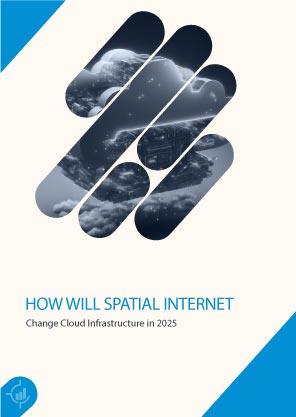or call: +1 (845) 347-8894

or call: +1 (845) 347-8894

Cloud infrastructure is facing its next great evolution. As we progress into 2025, the emerging force behind this transformation is the Spatial Internet, a paradigm shift that goes far beyond web pages and apps. It’s the foundation for immersive, intelligent, and real-time digital environments that blur the lines between physical and virtual worlds. But how exactly will this reshape the cloud infrastructure stack?
This article explores the unfolding impact of the Spatial Internet on cloud infrastructure in 2025, revealing how tech leaders should rethink architecture, latency, data locality, and security in a world that demands persistent digital presence and spatial computation.
The Spatial Internet is not merely an extension of AR, VR, or MR technologies. Instead, it’s a convergence layer where 3D interfaces, geolocation, real-time data, AI, and digital twins come together to create a dynamic, immersive web. Users don’t just access content; they navigate and interact within it spatially.
By 2025, this shift will demand cloud systems that can support real-time, spatially aware applications that integrate with sensors, edge devices, and AI-powered interfaces. Cloud providers will need to cater to experiences that are interactive and persistent, whether in retail, manufacturing, healthcare, or remote collaboration.
Traditional cloud models were built around centralization. The Spatial Internet breaks that model. To enable truly immersive and responsive experiences, spatial applications require ultra-low latency and hyper-local computation.
As David Randle, Worldwide Head of Go-to-Market for Spatial Computing at AWS, reports:
Spatial computing is the technology that enables this more natural understanding and awareness of physical and virtual worlds. It involves blending real-time operational data with three-dimensional data to create digital representations that mirror the real world.
This necessity shifts cloud infrastructure from centralized hyperscale data centers to a spatially distributed architecture.
Edge computing isn’t new, but the Spatial Internet accelerates its importance. Cloud services in 2025 will increasingly need to operate on a hybrid mesh of edge nodes, micro data centers, and decentralized systems. Providers that once scaled vertically will need to focus on horizontal extensibility, ensuring data and compute follow users and devices across physical geographies.
For example, a digital twin used in logistics that mirrors real-time movement of goods across cities will require edge deployments in proximity to warehouses, shipping yards, and distribution centers.
Spatial applications generate massive volumes of real-time data, from 3D mapping, biometric inputs, and lidar scans to contextual sensor data. Cloud infrastructure must evolve to accommodate:
In 2025, storage strategies will move beyond capacity and focus on context-aware data orchestration. Storing where, when, and why data was captured becomes as critical as storing the data itself.
Security for the Spatial Internet isn’t just about device access or API protections, it’s about dynamic identity in persistent, context-rich environments. This introduces new security challenges that will transform cloud IAM (identity and access management) systems:
Cloud security services in 2025 will evolve to track not only who accessed data, but where and how they accessed it within the spatial environment.
APIs have been the lifeblood of cloud integrations. In the Spatial Internet era, they must evolve to support spatial awareness and sensory input. RESTful APIs alone will not suffice.
Cloud platforms must now support:
These APIs enable digital experiences to adapt in real time to user behavior and environmental variables, forming a core component of spatial cloud architecture.
Cloud-based AI models will need to become situationally aware in 2025. As users move through spatial environments, AI must interpret spatial intent, behavioral cues, and ambient data to enhance user experience.
By 2025, more than 50% of data is expected to be generated by edge devices, enabling on-device AI processing.
Spatial Internet applications will increasingly leverage:
All of these require GPU-heavy infrastructure and AI model orchestration built into the cloud layer, signaling a move toward AI-native cloud architectures.
Bandwidth is no longer just a throughput concern; it becomes an experience enabler. With Spatial Internet applications demanding ultra-low latency and high throughput simultaneously, networking in 2025 will need a complete overhaul.
Key trends reshaping cloud networking:
To meet the demands of real-time collaboration in virtual spaces, cloud providers will prioritize proximity-aware service delivery, making network location as important as data center availability zones.
Spatial Internet introduces a new layer of abstraction for developers: space. This will reshape cloud-native development practices in 2025. Infrastructure-as-Code (IaC) will extend into Spatial Infrastructure-as-Code, where developers configure persistent environments with behaviors, assets, and context rules.
Moreover, DevOps will evolve into SpatialOps, where observability tools track user presence, device location, and interaction patterns. Developers will also need new tools to simulate spatial applications in various real-world contexts before deployment.
The expansion of spatial data processing raises questions about energy efficiency and data sovereignty. In 2025, sustainability and compliance will be top concerns for cloud infrastructure teams.
Cloud vendors that build transparency and adaptability into their spatial systems will gain long-term trust.
The Spatial Internet is not an incremental trend; it’s a foundational shift. For cloud infrastructure in 2025, this means moving from static compute models to dynamic, context-aware systems that blend edge, AI, networking, and real-time intelligence.
Tech leaders who want to stay ahead must adopt a spatial-first mindset, rethinking architecture, security, data strategy, and user experience from the ground up. Cloud infrastructure will no longer be a passive utility; it will be a responsive, immersive, and intelligent layer that underpins a new dimension of digital interaction.
The Spatial Internet extends the traditional Internet by integrating spatial data, 3D environments, and real-world context into digital experiences. Instead of just viewing content on a flat screen, users interact with digital elements anchored in physical space, enabling immersive applications in AR, VR, and beyond.
The Spatial Internet demands ultra-low latency, massive data throughput, and distributed computing power, pushing cloud infrastructure to become more spatially distributed. This means a significant shift toward edge computing and localized data centers to support real-time, context-aware spatial applications.
Edge computing processes data closer to where it’s generated, minimizing latency and bandwidth use. For spatial applications that require real-time responsiveness, such as AR navigation or industrial automation, edge computing is essential to deliver seamless user experiences.
AI and ML will provide contextual intelligence by interpreting spatial data, recognizing environments, and enabling interactions. They will power scene understanding, predictive analytics, and dynamic content generation, making spatial experiences more natural and adaptive.
With data spread across numerous edge locations and persistent spatial layers, securing data and verifying identities becomes more complex. New protocols and decentralized identity systems will be necessary to protect user privacy and maintain trust in spatial networks.
To participate in our interviews, please write to our IntentTech Media Room at sudipto@intentamplify.com
